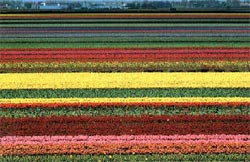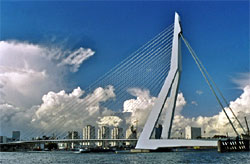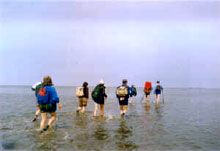|
|
|
|
Top Netherlands Destinations:
Amsterdam hotels Rotterdam hotels Maastricht hotels The Hague hotels Utrecht hotels See more hotels in Netherlands
World Destinations:
 Guides » Netherlands » Traveling to the Netherlands Guides » Netherlands » Traveling to the NetherlandsTraveling to the Netherlands
The Netherlands is a country different from others in a number of ways. Considered extremely liberal, there you can get a sex change operation and no one thinks anything of it. The fascinating aspect of this is that while the Netherlands has adopted such liberal ways, they also have one of the oldest societies on the planet.
You will quickly discover that the Dutch do not pay much attention to clichés. For the environment and countryside, seeing windmills, dykes, old-fashioned bicycles, and fields of magnificently colored flowers are commonplace. For tourists, this blend of new and old works very well. The people are warm and friendly, speaking English well although the towns are nestled among castle walls, and canals.  Because of the sprawling hills of beautiful greenery and flowers, this is truly a wonderful place to visit. The total population of the Netherlands is just over 15 million with 725,000 people living in the capital city of Amsterdam. While the majority of people are Christian, being protestant and catholic, there is also a small group of Muslim. Because of the wonderful balance seen in the Netherlands, people looking for a destination in Europe should definitely add this to the list of considerations. Because of the sprawling hills of beautiful greenery and flowers, this is truly a wonderful place to visit. The total population of the Netherlands is just over 15 million with 725,000 people living in the capital city of Amsterdam. While the majority of people are Christian, being protestant and catholic, there is also a small group of Muslim. Because of the wonderful balance seen in the Netherlands, people looking for a destination in Europe should definitely add this to the list of considerations.
Until the 16th century, the three areas of Belgium, Luxembourg, and the Netherlands were known as the "low countries". In the early days, the land was inhabited by various tribal groups to include the Germanic Batavi that were known for draining sea lagoons and the Frisii that lived in the north on mounds. Then in the latter part of the century, the people living in the north began to convert to Protestantism, determined to fight against Catholic Spanish leaders. At that point, Philip II from Spain sent out an inquisition that Catholicism would be enforced with the result of war in 1568. This revolt was led by Prince William of Orange, often called "William the Silent". However, after 80 years of battling with Holland, the Spaniards were finally expelled in 1648. Starting in 1580 until 1740, which was called the Golden Age, Amsterdam came into the European scene and shortly after, the British took control over the seas. The wealth from this particular era came from the Dutch East India Company that had sent numerous ships into the Far East in an attempt to find spices and various exotic goods. This time was also when Cape of Good Hope, Surinam, Indonesia, Antilles, and New Amsterdam, which is currently New York, were all colonized and Asia began seeing the establishment of trading posts. While all this was occurring, the affluent people of Amsterdam were indulging in gabled canal houses, self-portraits, and fine restaurants. The result was a growth in the world of art and the arrival of famous artists such as Rembrandt. However, this time of indulgence and growth only lasted until 1795 when there was a French invasion and Napoleon Bonaparte named his younger brother as Louis the King. Keep in mind that the French occupation was not popular, which ended it. With that, the UK of the Netherlands incorporated both Belgium and Luxembourg. Then in 1814, William I of Orange took the throne as the first king and even to today, the House of Orange rules the Netherlands. Just 26 years later, Belgium rebelled, pulling away to become an independent country, which was soon followed by Luxembourg. Even through all the turmoil of World War I, the Netherlands remained neutral but during World War II, they were invaded by the Germans in 1940. Sadly, a large portion of Rotterdam was obliterated during a massive bombing frenzy. This led to Indonesia finally becoming independent, followed by Suriname and Antilles. Being a firm supporter of the European Union the Netherlands were integrated into the system. While this country had its fair share of trials throughout the years of development and growth, the Netherlands has been far more fortunate than many other European countries. The Netherlands is known for many things, one being the variety of famous painters to include again, Rembrandt, Jan Vermeer, Frans Hals, Hieronymous Bosch, and others. You will also find the food in the Netherlands to be simply wonderful. Although the Dutch are big dairy product eaters, these people also have a natural love of sweets. With communities throughout the Netherlands of Chinese, Turkish, Italian, Indonesian, and Surinamese, you will find a nice variety of cuisine. One of the most common foods is called Frites, which are chips. You will even find various types of hot meat dispensed in vending machines. For beverages, most people drink Jetson’s Beer. Another fascinating thing about the Netherlands is that while Marijuana is not actually legal, you can buy it in registered coffee shops. In addition, magic mushrooms are commonly sold. Just because drugs are sold in most cities within the Netherlands, most Dutch do not participate. In fact, it is estimated that as few as 5% get involved with the drug scene. Unfortunately, hard drugs have become a problem in the Netherlands and today, street dealers are being given firm warnings about heavy penalties. Much of the country is wet but still well protected by dykes. Because more than 50% of the Netherlands is below sea level, dams and dykes are common. The only part of the country featuring hills is in the southeast where you will find the Limburg province. Surrounded by Belgium Germany, and the North Sea, you have beautiful countryside. The primary river is the Rhine, which is comprised of water coming down the mountains of Switzerland and Germany. Unfortunately, because of being below sea level and with so much surrounding water, disasters have occurred. For example, in 1953, a massive tide hit the country along with a major storm that did severe damage to the Zeeland dykes. The result was close to 2,000 people lost their lives. To ensure this type of major catastrophe would never again occur, the southwest river deltas were blocked using a series of dykes, dams, and a huge storm surge barrier. However, in 1995, the Meuse and Waal Rivers would overflow because of heavy rain in France. Fearing the dykes would not hold and the rivers would simply burst, close to 250,000 people were moved to Gelderland. Interestingly, the Netherlands is the most densely populated country in all of Europe with certain cities to include Amsterdam, Hague, and Rotterdam being the most densely populated in the world. Because of this, as you travel from one area of the Netherlands to another, you will simply blend from one town to the next. When choosing the best time of year, keep in mind that the winters are relatively cool. However, the summer months are mild but you will have some level of rain regardless of when you visit. Therefore, just be sure to bring warm clothing for cool nights and some type of raingear. Undeniably, the Netherlands is a beautiful country with wonderful people. There is plenty to do for people of all ages, making this an excellent European vacation spot. Last Updated: 10/19/2006 3:14:00 PM Mode articles for Netherlands The Netherlands is a European country beaming with amazing cities such as Amsterdam. With around 725,000 people living in this city, you will find a unique reputation for tolerating things other cities and countries
The Netherlands is a European country beaming with amazing cities such as Amsterdam. With around 725,000 people living in this city, you will find a unique reputation for tolerating things other cities and countries ... continue >>  Because of the unique blend of old and new found in the Netherlands, the cities are very charming and a real joy to visit. Take the capital city of Amsterdam for example. With less than one million people calling this
Because of the unique blend of old and new found in the Netherlands, the cities are very charming and a real joy to visit. Take the capital city of Amsterdam for example. With less than one million people calling this ... continue >>  Located just to the north of Amsterdam in the Netherlands, you will find five islands where tourists come from around the world to enjoy.
Located just to the north of Amsterdam in the Netherlands, you will find five islands where tourists come from around the world to enjoy.... continue >> |
|
| | |
|
©2025 HotelsRu.com About us Privacy Site map Traveling to the Netherlands |
|
 Look for deals on hotels?
Look for deals on hotels?